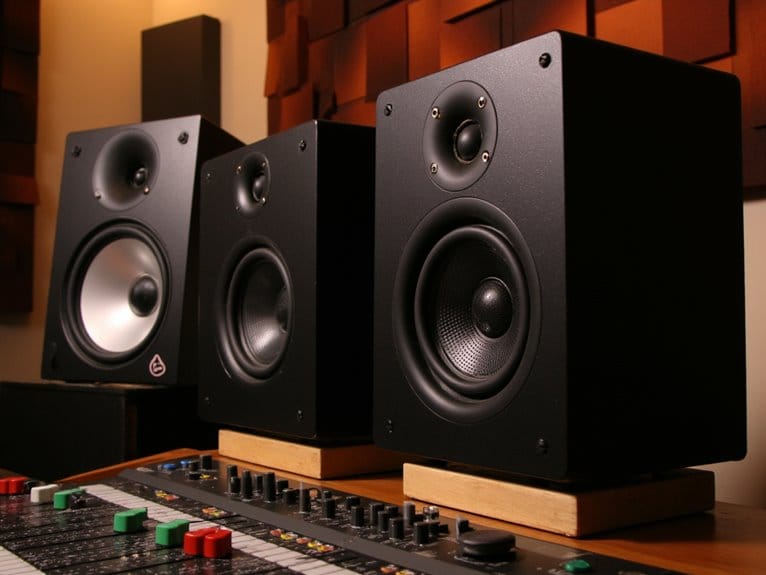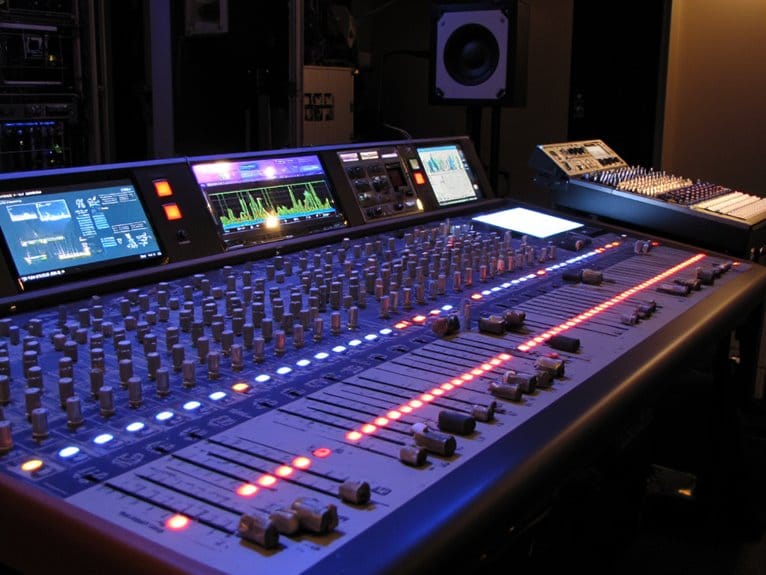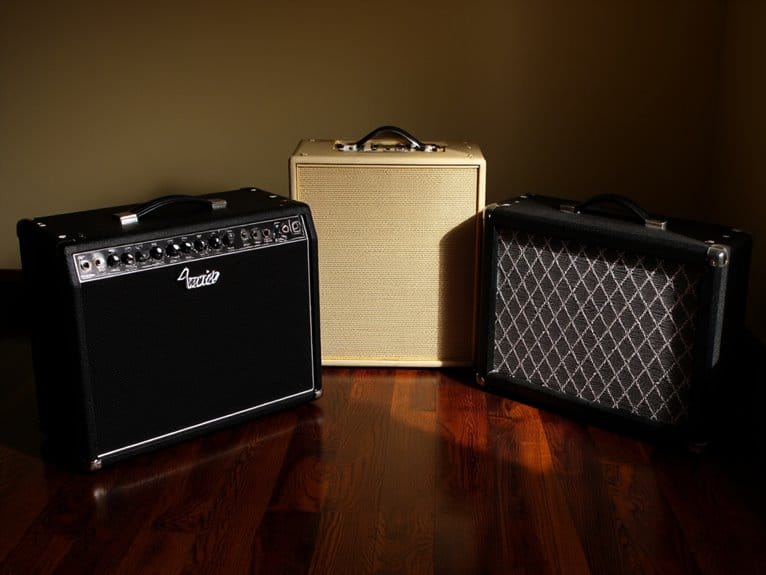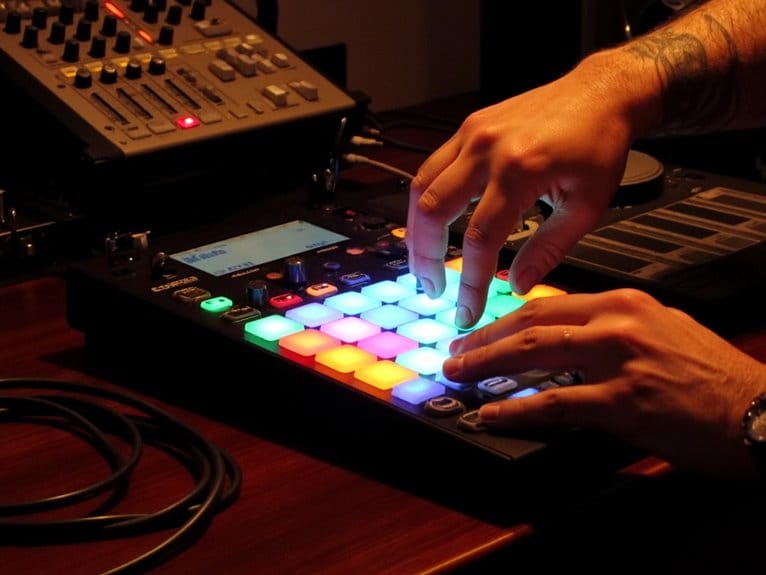What Are Studio Monitors and How Do They Differ From Regular Speakers
Studio monitors are precision-engineered speakers designed to deliver flat, uncolored sound reproduction for professional audio work, while regular speakers enhance certain frequencies to make music sound more pleasing. You’ll find monitors feature active amplification with built-in amps for each driver, balanced XLR connections, and target a flat frequency response within ±3 dB tolerance—enabling accurate mixing decisions that translate across different playback systems, unlike consumer speakers that prioritize listening enjoyment over surgical precision.
We are supported by our audience. When you purchase through links on our site, we may earn an affiliate commission, at no extra cost for you. Learn more.
Notable Insights
- Studio monitors are engineered for flat frequency response and accuracy, while regular speakers enhance sound for entertainment listening.
- They feature active designs with built-in amplifiers for each driver, unlike most consumer speakers that require external amplification.
- Studio monitors target precise ±3 dB frequency tolerance across their range for critical mixing and mastering work.
- Professional connectivity includes balanced XLR and TRS inputs, while consumer speakers typically use basic RCA or 3.5mm connections.
- They prioritize surgical precision for detecting mix issues rather than providing enhanced, colored sound for casual enjoyment.
Definition and Core Purpose of Studio Monitors
While most people think all speakers are created equal, I’ve learned through years of audio production that studio monitors represent a fundamentally different breed of loudspeaker, one that’s engineered specifically for the unforgiving demands of professional audio environments where accuracy trumps everything else.
Unlike consumer speakers that enhance your listening experience with boosted bass or shimmering highs, studio monitors deliver brutally honest sound reproduction without any frequency coloration or embellishment.
Studio monitors strip away all flattery and enhancement to reveal the raw, unvarnished truth of your audio recordings.
You’ll find various studio monitor types designed for critical listening, mixing, and mastering applications, each maintaining that essential flat frequency response that lets you hear exactly what you’ve recorded. Studio monitors with 5-inch woofers provide superior bass response compared to smaller drivers, making them particularly valuable for electronic music production where low-end accuracy is crucial.
This uncompromising accuracy enables precise mix decisions that translate well across different playback systems, from car stereos to high-end home audio setups. Professional studio monitors typically feature 24-bit DACs and carbon fiber drivers to achieve the precise frequency response that audio professionals demand for accurate monitoring.
Audio engineers and musicians rely on studio monitors to make informed decisions during the mixing process, ensuring their final products sound consistent regardless of the listening environment. Many professional monitors incorporate acoustic tuning controls that allow precise adjustments based on room acoustics and placement requirements. The premium components used in studio monitors contribute to their higher price point compared to ordinary speakers, but this investment reflects the superior build quality necessary for professional audio work.
Technical Design and Engineering Differences
This fundamental difference in purpose manifests most clearly in the engineering DNA of studio monitors, where every component, from the internal amplifiers to the cabinet acoustics, reflects a design philosophy that prioritizes surgical precision over consumer appeal.
You’ll find that studio monitors largely feature active designs with built-in amplifiers for each driver, while regular speakers rely on single external amplifiers. This active approach enables superior crossover engineering through electronic filtering before amplification, creating steeper frequency slopes and minimal driver interference.
The driver configurations in studio monitors—typically two-way or three-way systems—are engineered for nearfield listening with controlled directivity, unlike regular speakers designed for broader room dispersion and ambient listening experiences. Professional studios often implement tri-amp systems that allocate separate amplifiers for each driver to achieve enhanced precision in frequency reproduction.
Studio monitors also incorporate built-in EQ controls for precise sound adjustment, allowing engineers to fine-tune frequency response characteristics directly at the source rather than relying on external processing equipment. When paired with professional recording equipment, studio monitors benefit from ultra-low latency performance that ensures real-time monitoring without audio delays that could compromise recording accuracy.
Frequency Response and Sound Accuracy Standards
When you examine the heart of what separates professional studio monitors from consumer speakers, frequency response becomes the defining battleground where accuracy either triumphs or falls victim to marketing-driven sound enhancement.
Studio monitors target flat frequency response across their range, typically 39 Hz to 25 kHz, ensuring every frequency reproduces at consistent volume levels without artificial coloration. This sound accuracy means you’ll hear recordings exactly as engineers intended, with deviations limited to ±3 dB tolerance.
Regular speakers deliberately boost bass and treble to sound exciting, but this enhancement masks essential details during mixing.
Professional monitors undergo individual testing in anechoic chambers, while advanced models include digital calibration tools like Genelec’s GLM application to compensate for room acoustics and maintain that vital flat response.
Amplification Systems and Connectivity Features
Unlike consumer speakers that rely on external amplifiers or receivers to drive their passive drivers, professional studio monitors embrace active amplification systems that house dedicated amplifiers directly within each speaker enclosure.
You’ll find various amplifier types in these monitors, with Class A-B dominating mid to high-end models for superior audio fidelity and minimal distortion, while Class D amplifiers power compact designs through efficient, space-saving technology.
Bi-amplification remains standard, dedicating separate amplifiers to woofers and tweeters for precise control, with power ratings spanning from 25W+25W in smaller units to impressive 150W+120W configurations in larger models.
Regarding input options, you’ll encounter balanced XLR connectors and TRS jacks designed for professional equipment compatibility, while consumer RCA inputs are strikingly absent, reflecting their studio-focused design philosophy.
Professional Applications Vs Consumer Use Cases
While I’ve spent countless hours in both professional studios and home listening rooms, the fundamental difference between these environments isn’t just about the equipment—it’s about the completely opposite goals they’re designed to achieve.
In professional settings, you’re working under strict professional standards where every detail matters, from detecting phase issues to ensuring mixes translate across different playback systems. Studio monitors reveal flaws ruthlessly, helping you catch problems before they reach clients. The goal is surgical precision, not enjoyment.
Consumer speakers, however, are engineered for casual listening pleasure, often enhancing bass or smoothing harsh frequencies to make music more enjoyable. You’re not analyzing audio—you’re experiencing it, which is why these speakers prioritize comfort over clinical accuracy.
This distinction is why professional monitors deliver flat frequency response, ensuring that no particular frequency range is artificially boosted or cut during critical mixing and production work.
Frequently Asked Questions
Can I Use Studio Monitors as Regular Speakers for Casual Music Listening?
You can use studio monitors for casual listening, but they’ll sound more clinical and reveal recording flaws. While sound quality is accurate, you might prefer regular speakers’ warmer, more forgiving sound for everyday music enjoyment.
How Much Should I Expect to Spend on Good Quality Studio Monitors?
You’ll find budget options starting around $100-200 per speaker for entry-level quality. The price range extends to $300-600 for mid-tier monitors, while professional-grade models cost $600-1500+ per speaker depending on features.
What Room Size and Acoustic Treatment Work Best With Studio Monitors?
You’ll want room dimensions around 10×12 to 15×20 feet for ideal monitoring. Add sound absorption through acoustic panels at reflection points, bass traps in corners, and monitor isolation pads to minimize coloration.
Do I Need an Audio Interface to Connect Studio Monitors to My Computer?
You don’t strictly need an audio interface, but it provides significant audio interface benefits like better sound quality and volume control. Consider monitor connection options including USB monitors, DACs, or direct computer connections for simpler setups.
How Do I Properly Position and Calibrate Studio Monitors in My Workspace?
Position your monitors at ear level in an equilateral triangle, angled toward you. Place them away from walls to reduce reflections. Use acoustic calibration with SPL meters and room treatment like bass traps for ideal sound accuracy.
On a final note
You’ll find that studio monitors aren’t just expensive speakers with fancy branding—they’re precision tools engineered for accuracy, not entertainment. If you’re serious about audio production, mixing, or mastering, they’ll reveal details that consumer speakers simply can’t deliver. While they won’t make your music sound “better” in the traditional sense, they’ll show you exactly what’s there, helping you create mixes that translate well across all playback systems.







